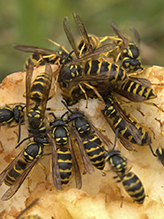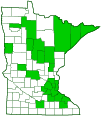downy yellowjacket
(Vespula flavopilosa)
Conservation • Description • Habitat • Ecology • Distribution • Taxonomy
Conservation Status |
|
|||||||
| IUCN Red List | not listed |
|||||||
| NatureServe | NNR - Unranked |
|||||||
| Minnesota | not listed |
|||||||
Description |
||
In eastern North America there are four Vespula species that closely resemble each other, common yellowjacket (V. alascensis), downy yellowjacket (V. flavopilosa), eastern yellowjacket (V. maculifrons), and German yellowjacket (V. germanica). This makes yellowjacket identification in the region difficult. Downy yellowjacket is a medium-sized, ½″ to ⅝″ long, predatory, social wasp. It closely resembles eastern yellowjacket. It is thought by some to be a hybrid between eastern yellowjacket (Vespula maculifrons) and common yellowjacket (V. alascensis). Others suggest that it probably arose as a hybrid but now queens mate with drones of the same species. There are two large compound eyes, one on each side of the head; and three small simple eyes (ocelli) at the top of the head between the compound eyes. The upper (dorsal) space between the compound eyes is entirely black—there is no yellow “eye loop”. The ridge on the rear of the head (occipital carina) is well developed through its entire length, and continues uninterrupted to the base of the jaw (mandible). The distance between the lateral ocelli and the occipital carina is about the same as the distance between the two lateral oceili. The yellow band on the area below the compound eye (gena) is continuous, not interrupted with black. The space between the bottom of the compound eye and the top of the mandible is narrow. The eyes touch, or almost touch, the mandibles. The antennae are long and black. Males have 12 antennal segments, females have 13. The hardened plate at the base of each antenna is yellow, the rest is black. The under (ventral) side of the first antenna segment (pedicel) is black, not yellow. The stout body is slightly wider than the head. The thorax is densely covered with long yellow hairs. A yellow band at the leading edge of the first section (pronotum) is interrupted nearest to the head (at the apex). The dorsal surface of the largest section (scutum) is black, and usually has no stripes down the middle. The abdomen of the female has six segments, while that of the male has seven segments. The upper plate (tergum) of each abdominal segment is yellow with black markings. The first tergum has a diamond-shaped basal mark that varies in width but is usually V-shaped, without a narrow “neck” at the base. The second tergum usually does not have black spots surrounded by yellow (free). The coloration of the thorax and abdomen is variable, some with more yellow (xanthic), others with more black (melanic). Xanthic individuals may have short yellow stripes on the scutum and small free black spots on the second abdominal tergum. The legs are yellow. The wings are clear. |
||
Size |
||
Workers: ½″ to ⅝″ |
||
Similar Species |
||
Habitat |
||
|
||
Ecology |
||
Season |
||
April through Autumn |
||
Behavior |
||
|
||
Life Cycle |
||
The overwintering queen emerges from hibernation in April or May. In early summer she builds an embryonic nest. The nest begins as just three hexagonal cells. Into each cell she deposits a single egg then covers the cell with fragile paper. She continues building 20 to 45 cells while caring for the grubs as they hatch. In about 30 days the workers emerge and take over nest building duties. The nest is constructed underground from fecal matter and chewed wood fibers (carton) cemented with saliva. The carton is tan and fragile, but noticeably sturdier than that of eastern and common yellowjackets. Through spring and summer the queen produces a large number of worker wasps. In mid-summer, the nest grows exponentially, as more and more workers become available, ultimately with 3,500 to 15,000 cells. In late summer the queen begins producing new queens and males. In Minnesota the nests do not survive the winter. Old queens, males, and workers are killed by cold weather in the fall. Only the new queens survive the winter. They mate with up to 7 males in the late summer or fall, then hibernate under loose tree bark, in a decaying stump, or in another sheltered location. |
||
Larva Food |
||
Pre-chewed fragments of caterpillars and other soft-bodied insects, and probably nectar and honeydew. |
||
Adult Food |
||
Live arthropods; carrion; fruit; honeydew of aphids, caterpillars, and some scale insects; human processed food and garbage; and other sources of protein and sugar. Queens feed on flower nectar in the spring. |
||
Distribution |
||||
|
Sources |
|||
| 8/29/2023 | ||||
Occurrence |
||||
Not common in Minnesota |
||||
Taxonomy |
|||
Order |
Hymenoptera (Ants, Bees, Wasps, and Sawflies) | ||
Suborder |
Apocrita (Narrow-waisted Wasps, Ants, and Bees) | ||
Infraorder |
Aculeata (Ants, Bees, and Stinging Wasps) | ||
Superfamily |
Vespoidea (vespoid wasps) | ||
Family |
Vespidae (hornets, paper wasps, potter wasps, and allies) | ||
Subfamily |
Vespinae (hornets and yellowjackets) | ||
Genus |
Vespula (ground yellowjackets) | ||
Synonyms |
|||
|
|||
Common Names |
|||
downy yellowjacket hybrid yellowjacket transition yellowjacket yellow-haired yellowjacket |
|||
One of the common names for this newly identified (1978) species is hybrid yellowjacket. This refers to the possibility that it may be a hybrid between eastern and German yellowjackets. |
|||
Glossary
Carina
An elevated keel or ridge.
Occiput
The back of the head. In Odonata, Megaloptera, and Neuroptera, the upper part of the head behind the eyes.
Ocellus
Simple eye; an eye with a single lens. Plural: ocelli.
Pronotum
The exoskeletal plate on the upper side of the first segment of the thorax of an insect.
Scutum
The forward (anterior) portion of the middle segment of the thorax (mesonotum) in insects and some arachnids.
Tergite
The upper (dorsal), hardened plate on a segment of the thorax or abdomen of an arthropod. Plural: terga.
Visitor Photos |
|||||
Share your photo of this insect. |
|||||
| This button not working for you? Simply email us at info@MinnesotaSeasons.com. Attach one or more photos and, if you like, a caption. |
|||||
Alfredo Colon |
|||||
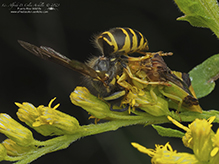 |
|||||
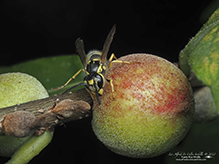 |
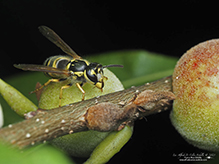 |
||||
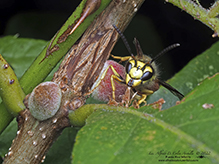 |
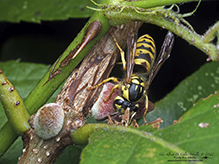 |
||||
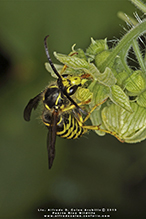 |
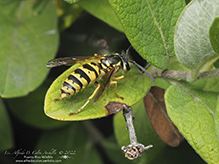 |
||||
Bill Reynolds |
|||||
Pretty dry up here and the wasps are out in great numbers. So far, they aren't bothering the honey bees. |
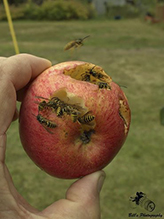 |
||||
MinnesotaSeasons.com Photos |
|||||
|
|||||

Slideshows |
||

Visitor Videos |
|||
Share your video of this insect. |
|||
| This button not working for you? Simply email us at info@MinnesotaSeasons.com. Attach a video, a YouTube link, or a cloud storage link. |
|||
Other Videos |
|||
| Downy Yellow Jacket Nest (Vespidae: Vespula flavopilosa) in Rodent Burrow Carl Barrentine |
|||
About
Published on Aug 12, 2010 Photographed at the Turtle River State Park, North Dakota (11 August 2010). If I counted correctly, I think that 13 individuals entered this burrow and 14 exited during this 70 second clip. Thank you to 'Vespula.vulgaris' (@Bugguide.net) for identifying a specimen from this colony! Go here to learn more about this species: http://www.discoverlife.org/mp/20q?search=Vespula+flavopilosa |
|||
| Vespula flavopilosa Nest # 1 - 2015 Casey Borowski Jr |
|||
About
Published on Sep 10, 2015 This video shows the worker activity of a nest of the Downy Yellowjacket, Vespula flavopilosa. Oregon Ridge Park, Cockeysville, Baltimore County, Maryland, USA. Filmed on August 16, 2015. |
|||
| Vespula flavopilosa abdominal signal maculifrons |
|||
About
Published on Jul 28, 2009 Look very closely at the workers. Some of them were vibrating their abdomen so rapidly that I could actually hear the sound created (although you can't here it in the video) I wonder what the use of this signal is for. Not all of the workers were doing it |
|||
| Her dying days maculifrons |
|||
About
Published on Oct 9, 2012 This is a rare glimpse of an old foundress, Vespula flavopilosa, in her dying days. She was extracted from her mature nest on October 8th |
|||


Created 9/6/2017
Last Updated:
